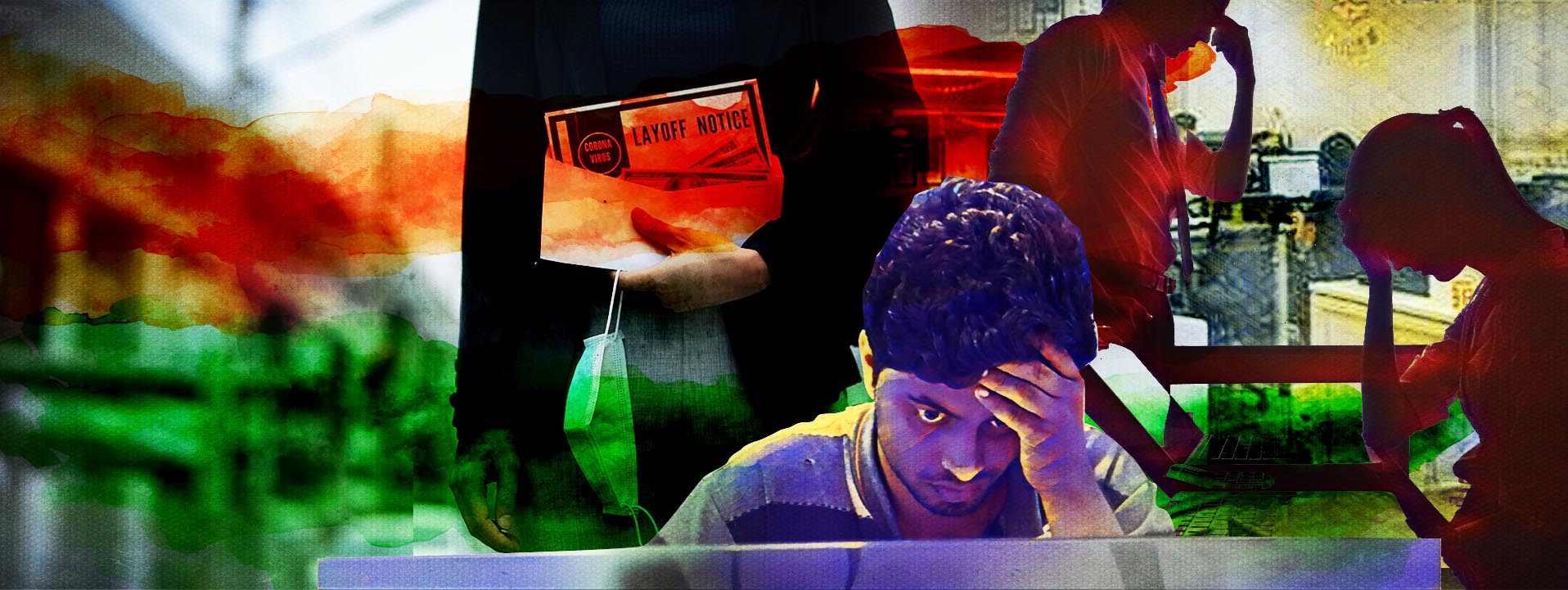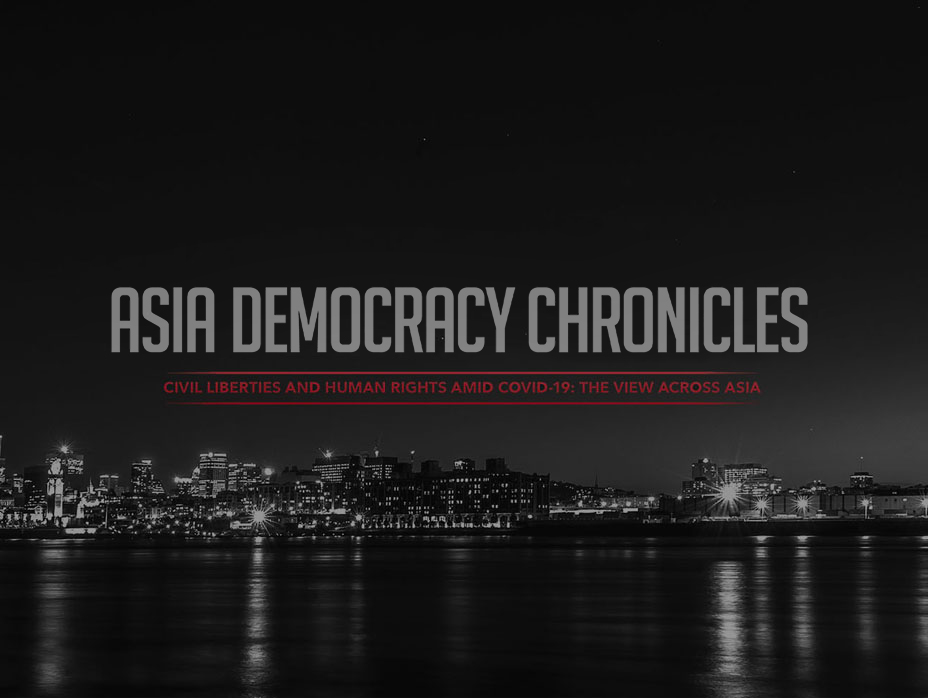COVID-19 has had an impact on several key sectors of the global economy and the media industry in South Asia has not remained untouched. In India alone, at least a thousand journalists have lost their jobs. This has had a chilling effect on journalists in the mainstream media, who choose to self-censor rather than question the government. Uday Rana speaks to journalist Cyril Sam, who has been tracking layoffs in the media, on the state of media freedom, government transparency, and a responsibility of care that media organizations owe to their employees amid the pandemic.
These developments are tracked on News@COVID19, where Sam lists incidents cited in the public domain and through verified tip-offs.
Listen to the following interview by Uday Rana (left photo) with fellow New Delhi-based journalist Cyril Sam (right), who reports on the news industry in India and who is the brains behind News@COVID19.
Transcript
UDAY RANA:
COVID-19 is one of those once-in-a-lifetime stories. Not only has the disease taken over 1.2 million lives, it has also put the global economy in jeopardy.
The media industry has not remained untouched by the economic devastation of the pandemic. All across the world, we are getting reports of journalists losing their jobs, taking pay cuts and news publications shutting down.
You’ve been tracking media layoff in India since the pandemic began, since before the pandemic began. How bad is it? what are the numbers?
CYRIL SAM:
What we’re looking at is that most newsrooms have laid off between 10 percent to 30 percent of their staff, a lot of big media companies, especially newspapers, have shut down bureaus and editions across many parts of the country. At the same time, we are seeing a lot of journalists who are contacting COVID and dying of COVID.
In terms of numbers, tracking English language news organizations in India, among English language news organizations in India, around 1,500 journalists have lost their jobs in the last six to eight months. Almost every day we see pay cuts happening.
In India 55 to 60 journalists have died, the second highest number of journalists who have succumbed to COVID-19 anywhere. Globally 400 journalists have died because of COVID-19.
India announced the lockdown on March 24. On March 20, the Ministry of Labor put out an advisory telling all employers in the country to pay their employees’ wages, not to deduct salaries and not to lay off anyone. After the lockdown was announced, the Ministry of Home Affairs published another advisory asking everyone not to lay off staff, not to deduct salaries and pay wages on time.
News organizations reported a lot of these and at the same time, the layoffs began. It is a little ironic that the reporting about labor laws, and all these advisories published by different ministries, at the same time journalists were losing jobs.
It is something very similar when it comes to journalists who are out there reporting because most news organizations have not provided journalists with any kind of protection. The only instance where a collective of journalists came together and provided personal protective equipment for journalists was in Bombay, and then again it was journalists who pooled money under the Bombay Press Club, and they bought personal protective equipment and distributed it among journalists.
News organizations have not done anything of this sort. As far as I know, there are no advisories, there are no protocols on how to report—it is all left to the reporters.
And what we have seen in terms how these organizations are behaving, not everyone has been allowed to work from home. People are expected to come to work. If you want to work from home, a lot of these organizations have imposed pay cuts.
And because of the way these organizations are behaving, we have also seen multiple newsrooms turning into COVID hotspots across the country. It is not just in the nerve centers of news in Delhi where newsrooms are turning into COVID hotspots. But across different parts of the country, news organizations are turning into COVID hotspots, infecting anyone who have come to work, or forced to come to work.
Regarding personal protective equipment, the number of journalists who succumbed COVID, a large number are photojournalists.
News organizations have more or less behaved in the most unprofessional manner, and not bothering or worrying about taking care of their employees.
RANA:
Is it just happening in India? What about in the region?
SAM:
I don’t know what the picture is like across the region. From what I understand, it’s not just journalists in India who have lost jobs, but also in Bangladesh, Sri Lanka, et cetera. The extent of job losses, the extent of salary cuts, whether or not these news organizations are behaving professionally, but speaking with people, what I understand, things are bad.
How bad are they, what does the picture looks like I don’t have too many details.
RANA:
Here’s another aspect about the media. Now we have reporters worried about losing their jobs, and therefore are less likely to take a stand against a problematic editorial staff. What do job cuts and salary cuts mean to the existence of a free and fair media in countries like India, Pakistan, and Bangladesh.
SAM:
I don’t have any details about what’s in the region in general.
But in India specifically, it always had a culture of self-censorship when it comes to news organizations. I understand, on some of my consultations with fellow journalists, investigative journalists are supposed to do two good stories in a month out of six or 10 stories that they produce. The moment you cross that number there is a pushback from news organizations. You are considered as someone who have an agenda, you are someone who is a reactionary or a revolutionary et cetera, et cetera, so there’s a lot of push back from newsrooms. What COVID has essentially done, self-censorship has increased to the extent that most people don’t want to talk about what is happening, forget about how the government is behaving or seeking accountability when it comes to the government, et cetera.
Even when it comes down to talking about what’s happening in the newsroom, most people do not want to talk about these things. Despite knowing that what’s happening is unfair and in most cases elitist.
Because the idea is you don’t want to rock the boat too much because rocking the boat too much might lead to the closure of the newsroom.
So it got to the point that there is increased self-censorship. There is no quantitative way of measuring how much increase there is. It’s all anecdotal.
We have seen multiple cases of threats, intimidation et cetera, cases filed et cetera, against journalists, et cetera. And if you look at the stats, outside of Kashmir which is a conflict region, India’s largest state of Uttar Pradesh is the most dangerous place for journalists right now.
RANA:
Is it some kind of a chilling effect?
SAM:
More or less, because if you look at what preceded the lockdown, it was announced around 6:00 to 8:00 pm on the March 24 by the Prime Minister. Hours before that, the Prime Minister had a meeting with media owners, asked media that there should be no negative portrayal of COVID-19. Days before that there was a meeting with television news owners with a similar message. A week or so before that conversation with radio owners and radio jocks.
The message was very clear you don’t go around looking for things, even if you look at the process of how the lockdown was announced. I find it very very strange that we still don’t know under what laws and how the lockdown was announced.
There is still no clarity how it was announced, and who advised the Prime Minister to announce the lockdown. Because lockdown massive humanitarian crisis, led to the largest internal migration that India has seen or probably the world has seen since India’s partition. The lockdown led to something even bigger.
We still don’t have a clear picture about what happened.
RANA:
It sounds like the media wasn’t interested enough to question enough about the humanitarian crisis.
SAM:
Media reported the humanitarian crisis in great detail, that people were traveling and moving, there were journalists who tracked migrants all the way to their villages, et cetera, et cetera, but fundamental questions about why the country’s entire transportation system was suspended, trains were suspended, aircraft were suspended, buses were suspended, a lot of these questions still remain unanswered. On whose advice, did no one think of the repercussions?
We don’t have any answers, and no one is interested in the answers.
The message was very clear that don’t go around doing any negative reporting around COVID.
Even the COVID data also, India’s data has been marked suspect by global organizations including the World Health Organization, and they said India’s data on COVID doesn’t apply. And that they are not looking at India’s data.
A news reporter based out of Delhi was pulled out by his editor because he asked the Delhi government questions about numbers. The editor pulled him out that you are an employee of this organization, you’re not an activist so stop asking questions.
RANA:
Coming back to the layoffs, what has it got to do with local reportage, in small towns, particularly in rural areas?
SAM:
In early 2000, a media study looked at coverage in rural area in newspapers, found that less than .2 percent of the news coverage was about rural India.
The lockdown has led to the point where rural reporting is difficult.
In terms of rural reporting, we don’t have any idea of what’s happening with rural India. Journalists are wary of traveling. Residents are wary of having outsiders coming to their villagers, having come to their towns, I don’t think we have any idea of what’s happening in large parts of this country.
RANA:
The future of journalism. What are the new trends emerging, will there be new kinds of journalism? What is it like in the future?
SAM:
There are fundamental changes that are happening because of what the new technology has done, because this whole thing about passing information, producing, and distributing information was an expensive affair.
That mission no longer works because the Internet has made collecting, producing, and distributing information nearly at zero cost. Most people have information about most things around them, and if people are recording history around them, journalists are no longer required to record the first draft of history anymore. People are recording the first draft of history.
So there are fundamental changes that are happening. I don’t think a lot of us are thinking about those fundamental changes that are happening.
Most new organizations in India have put up paywalls. How successful something like this going to be in a country with a low per capita income and a low Internet penetration, I don’t know.
What I do understand is that advertising creates success. Paywalls create barriers at a time when we are going through a huge political, economic, and health-related turmoil. I don’t think we need to erect more barriers—we need to create more access.
What does the future look like? I don’t know but I what I do realize that I don’t think we will have the kind of journalists in terms of the numbers that we saw a decade ago or two decades ago.
What do they report on, how do they report, what news organizations will look like—I think these are all open questions right now. ●


















